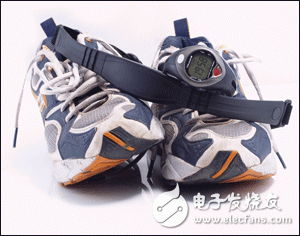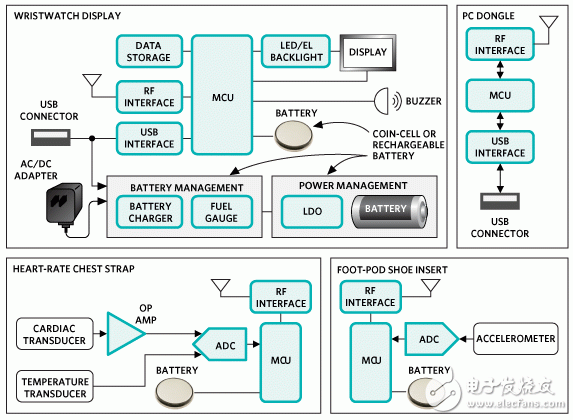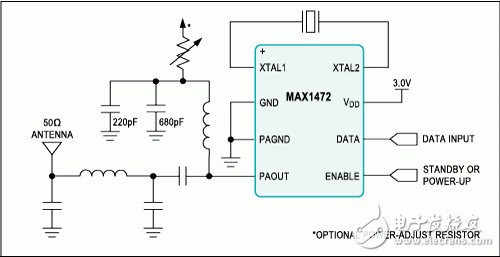Abstract: This article introduces the development trend of heart rate / fitness monitors towards wireless, that is, to replace wired interconnection with wireless, so that users can get rid of the shackles of cables and can move freely. While wireless communication facilitates data collection, connection cables are omitted. This article describes a typical wireless system in detail, using the MAX1472 crystal-based phase-locked loop VHF / UHF transmitter.
![]()
Fitness monitors track and record the movement of the body, so as to achieve the purpose of improving health. By measuring a large number of parameters, such as heart rate, body temperature, exercise distance and time, a watch-style device can collect information and display the results to the user. The heart rate recording tape can measure the pulse, and sometimes also record the body temperature, and convert the recorded signal to data, and wirelessly transmit the data to the watch for display. You can choose a pedometer and judge the running distance according to the runner's festival. The pedometer will wirelessly transmit the data to the watch for display (Figure 1). Some fitness monitors use GPS to measure walking distance, replacing the function of a pedometer. These systems are beginning to gradually switch to wireless data transmission. After all, it is very inconvenient to require users to "connect" the monitor to collect data during the movement.

Figure 1. Sneakers with wireless communication capabilities can record runner data and send it to a digital watch display to provide valuable feedback.
Design Parameters
The watch monitors the data in real time and records the results to external or processor (MCU) internal memory, and then uploads the data to the computer using a USB cable or wireless dongle. Such systems usually use only a tiny battery to power them, so the power consumption requirements of RF transmitters are very strict (some products also require compliance with FCC regulations). In order to ensure low-power transmission, good antenna design is critical to ensure reliable data transmission, even if the transmission distance is generally within 2 meters. Amplitude shift keying (ASK) has better sensitivity than frequency shift keying (FSK), is more suitable for this occasion, and has lower transmission power consumption. The low duty cycle can shorten the transmission time, and the transmitter can be turned off during the idle period to save power.
All parts of the fitness monitor, except the PC dongle, are worn on the user and powered by batteries. Therefore, small size and low power consumption have become very important design parameters. The heart rate belt and pedometer are usually powered by a disposable button battery. The display function of the watch can be powered by a disposable button battery or a rechargeable battery. Charging is often through an AC adapter or a USB cable. Watch display often uses simple segment LCD and controllable backlight.
The system architecture is shown in Figure 2. The RF interface and power management are combined to effectively extend battery life. In addition, the system also provides a variety of sensor interfaces and host interfaces. The RF interface of the system can choose MAX1472, as shown in Figure 3. The MAX1472 is a crystal-based phase-locked loop (PLL) VHF / UHF transmitter used to transmit OOK / ASK data in the 300MHz to 450MHz frequency band. The device supports data rates up to 100Kbps and can provide an output power greater than + 10dBm (adjustable) for 50Ω loads. The MAX1472 crystal-based architecture can provide higher modulation depth, faster frequency settling time, and higher transmission frequency accuracy, while also reducing the effects of temperature and overcoming many limitations of SAW transmitters.

Figure 2. A typical heart rate monitoring data collection system, consisting of several subsystems: watch display / data storage unit (upper left), wireless adapter for connecting to the host (upper right), heart rate monitor strap (lower left), and pedometer Device (bottom right). All these subsystems work in low-power wireless mode.

Figure 3. The MAX1472 low-power RF transmitter transmits the serial data stream based on OOK / ASK modulation.
Fuel Filter For NISSAN
Nissan Fuel Filter,Nissan Auto Fuel Filter,Nissan Automobile Fuel Filter,Nissan Car Fuel Filter
Zhoushan Shenying Filter Manufacture Co., Ltd. , https://www.renkenfilter.com